BSc Business Management BMP3004: Understanding Employee Motivation
VerifiedAdded on 2023/06/18
|8
|2022
|147
Report
AI Summary
This report, submitted as part of a BSc (Hons) Business Management program, delves into the multifaceted nature of employee motivation. It begins by defining motivation and exploring Maslow's Hierarchy of Needs, differentiating between physiological, safety, love and belongingness, esteem, and self-actualization needs. The report further distinguishes between extrinsic and intrinsic motivation, highlighting factors like salary, promotion opportunities, and work environment as key motivators. It also examines positive factors such as good relationships with colleagues, job security, and learning opportunities, alongside negative factors like workplace conflict, poor management, and a negative work environment. The report concludes by suggesting strategies for organizations to mitigate these negative factors, emphasizing the importance of employee voice, trust, and respect. The overall aim is to provide a comprehensive understanding of why people work and how organizations can foster a more motivating and satisfying work environment.
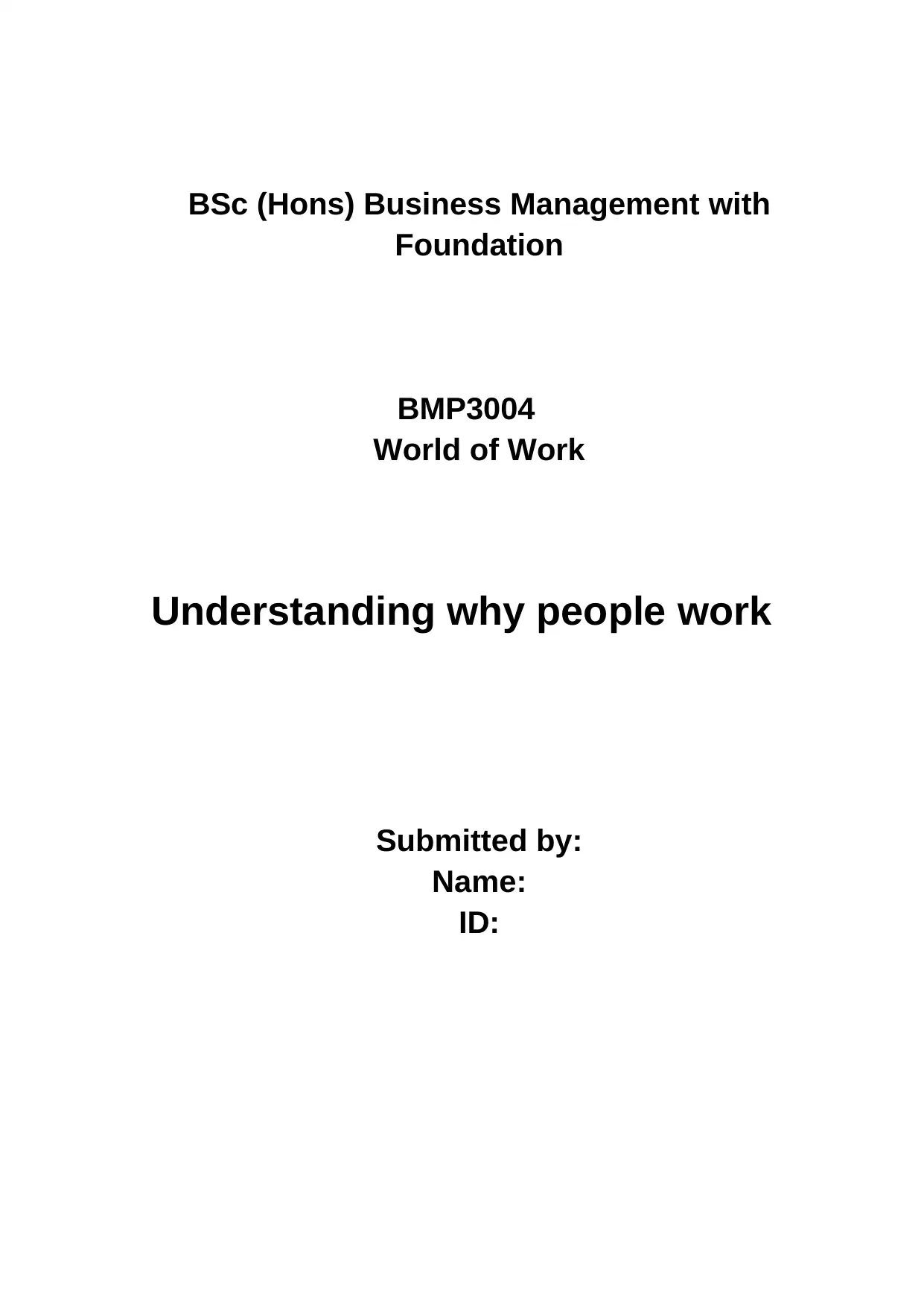
BSc (Hons) Business Management with
Foundation
BMP3004
World of Work
Understanding why people work
Submitted by:
Name:
ID:
Foundation
BMP3004
World of Work
Understanding why people work
Submitted by:
Name:
ID:
Paraphrase This Document
Need a fresh take? Get an instant paraphrase of this document with our AI Paraphraser
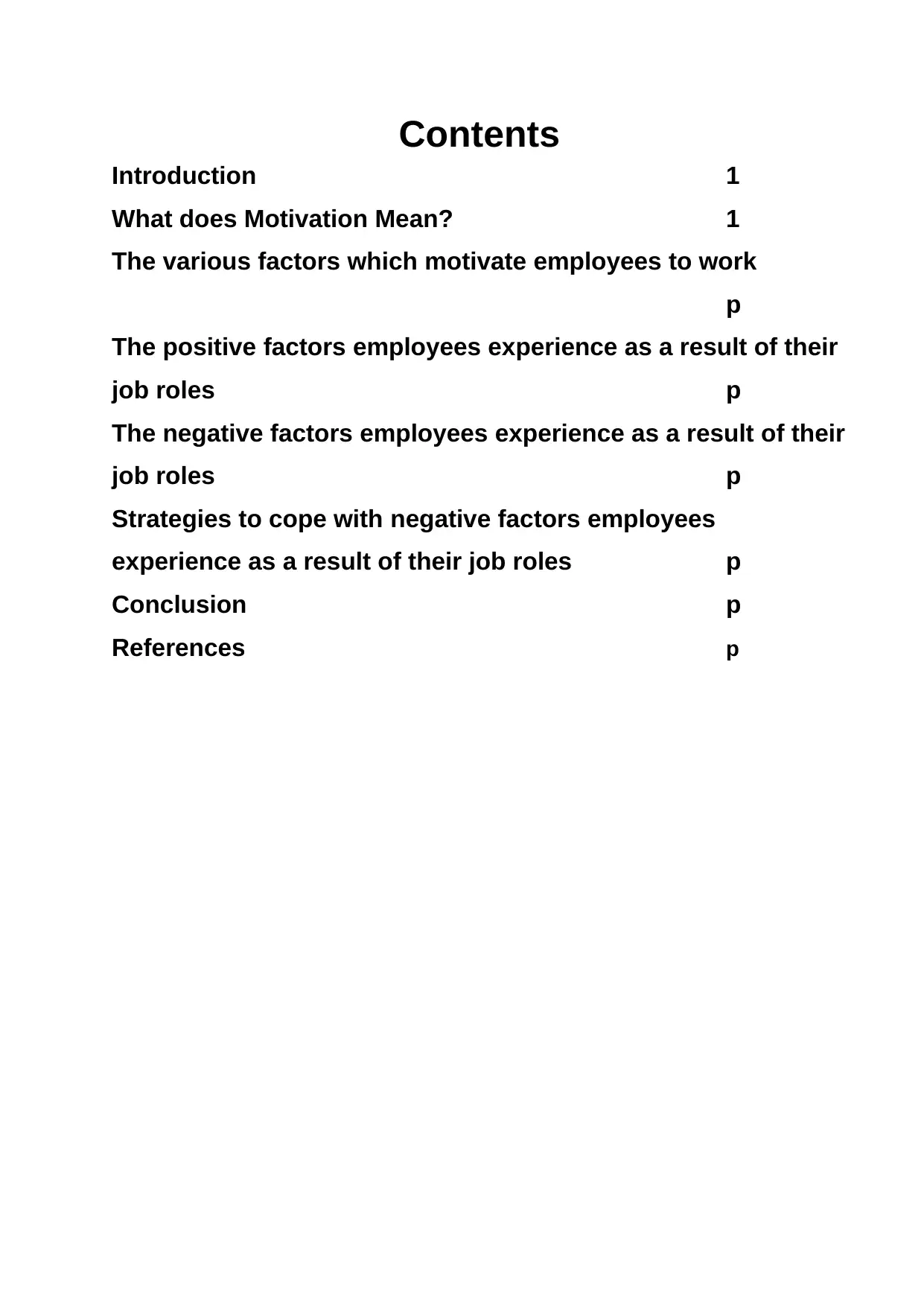
Contents
Introduction 1
What does Motivation Mean? 1
The various factors which motivate employees to work
p
The positive factors employees experience as a result of their
job roles p
The negative factors employees experience as a result of their
job roles p
Strategies to cope with negative factors employees
experience as a result of their job roles p
Conclusion p
References p
Introduction 1
What does Motivation Mean? 1
The various factors which motivate employees to work
p
The positive factors employees experience as a result of their
job roles p
The negative factors employees experience as a result of their
job roles p
Strategies to cope with negative factors employees
experience as a result of their job roles p
Conclusion p
References p
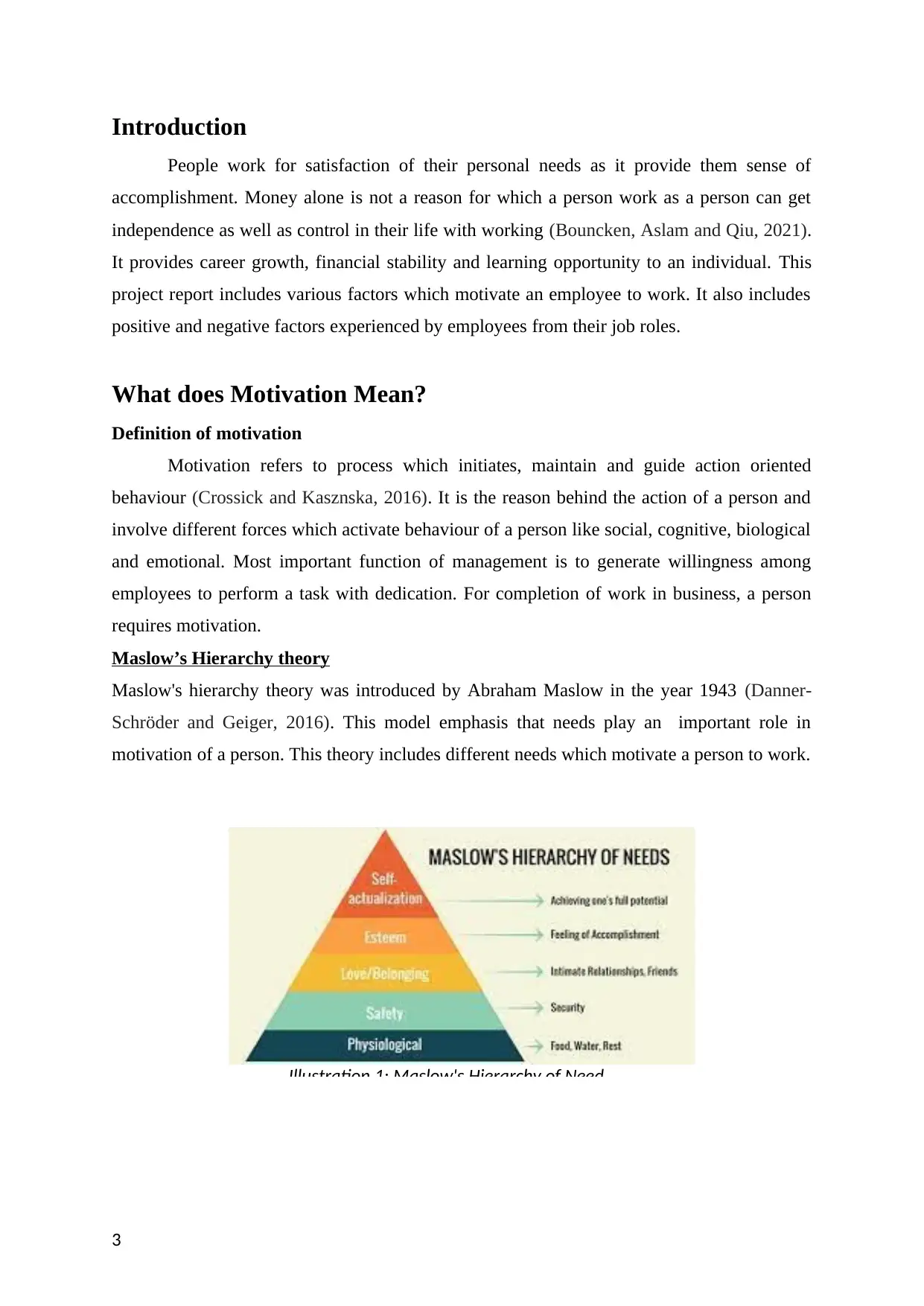
Introduction
People work for satisfaction of their personal needs as it provide them sense of
accomplishment. Money alone is not a reason for which a person work as a person can get
independence as well as control in their life with working (Bouncken, Aslam and Qiu, 2021).
It provides career growth, financial stability and learning opportunity to an individual. This
project report includes various factors which motivate an employee to work. It also includes
positive and negative factors experienced by employees from their job roles.
What does Motivation Mean?
Definition of motivation
Motivation refers to process which initiates, maintain and guide action oriented
behaviour (Crossick and Kasznska, 2016). It is the reason behind the action of a person and
involve different forces which activate behaviour of a person like social, cognitive, biological
and emotional. Most important function of management is to generate willingness among
employees to perform a task with dedication. For completion of work in business, a person
requires motivation.
Maslow’s Hierarchy theory
Maslow's hierarchy theory was introduced by Abraham Maslow in the year 1943 (Danner-
Schröder and Geiger, 2016). This model emphasis that needs play an important role in
motivation of a person. This theory includes different needs which motivate a person to work.
3
Illustration 1: Maslow's Hierarchy of Need
People work for satisfaction of their personal needs as it provide them sense of
accomplishment. Money alone is not a reason for which a person work as a person can get
independence as well as control in their life with working (Bouncken, Aslam and Qiu, 2021).
It provides career growth, financial stability and learning opportunity to an individual. This
project report includes various factors which motivate an employee to work. It also includes
positive and negative factors experienced by employees from their job roles.
What does Motivation Mean?
Definition of motivation
Motivation refers to process which initiates, maintain and guide action oriented
behaviour (Crossick and Kasznska, 2016). It is the reason behind the action of a person and
involve different forces which activate behaviour of a person like social, cognitive, biological
and emotional. Most important function of management is to generate willingness among
employees to perform a task with dedication. For completion of work in business, a person
requires motivation.
Maslow’s Hierarchy theory
Maslow's hierarchy theory was introduced by Abraham Maslow in the year 1943 (Danner-
Schröder and Geiger, 2016). This model emphasis that needs play an important role in
motivation of a person. This theory includes different needs which motivate a person to work.
3
Illustration 1: Maslow's Hierarchy of Need
⊘ This is a preview!⊘
Do you want full access?
Subscribe today to unlock all pages.

Trusted by 1+ million students worldwide
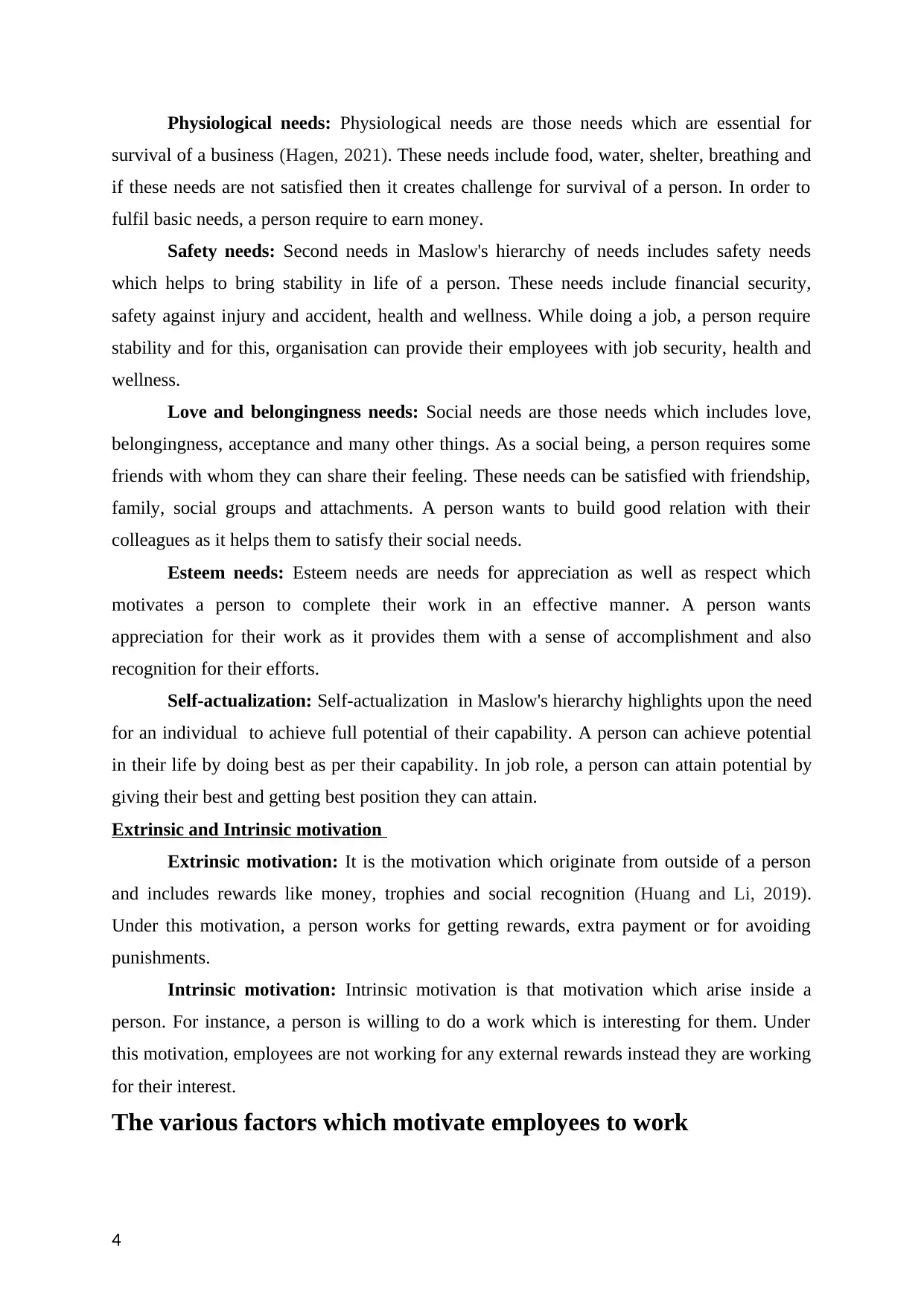
Physiological needs: Physiological needs are those needs which are essential for
survival of a business (Hagen, 2021). These needs include food, water, shelter, breathing and
if these needs are not satisfied then it creates challenge for survival of a person. In order to
fulfil basic needs, a person require to earn money.
Safety needs: Second needs in Maslow's hierarchy of needs includes safety needs
which helps to bring stability in life of a person. These needs include financial security,
safety against injury and accident, health and wellness. While doing a job, a person require
stability and for this, organisation can provide their employees with job security, health and
wellness.
Love and belongingness needs: Social needs are those needs which includes love,
belongingness, acceptance and many other things. As a social being, a person requires some
friends with whom they can share their feeling. These needs can be satisfied with friendship,
family, social groups and attachments. A person wants to build good relation with their
colleagues as it helps them to satisfy their social needs.
Esteem needs: Esteem needs are needs for appreciation as well as respect which
motivates a person to complete their work in an effective manner. A person wants
appreciation for their work as it provides them with a sense of accomplishment and also
recognition for their efforts.
Self-actualization: Self-actualization in Maslow's hierarchy highlights upon the need
for an individual to achieve full potential of their capability. A person can achieve potential
in their life by doing best as per their capability. In job role, a person can attain potential by
giving their best and getting best position they can attain.
Extrinsic and Intrinsic motivation
Extrinsic motivation: It is the motivation which originate from outside of a person
and includes rewards like money, trophies and social recognition (Huang and Li, 2019).
Under this motivation, a person works for getting rewards, extra payment or for avoiding
punishments.
Intrinsic motivation: Intrinsic motivation is that motivation which arise inside a
person. For instance, a person is willing to do a work which is interesting for them. Under
this motivation, employees are not working for any external rewards instead they are working
for their interest.
The various factors which motivate employees to work
4
survival of a business (Hagen, 2021). These needs include food, water, shelter, breathing and
if these needs are not satisfied then it creates challenge for survival of a person. In order to
fulfil basic needs, a person require to earn money.
Safety needs: Second needs in Maslow's hierarchy of needs includes safety needs
which helps to bring stability in life of a person. These needs include financial security,
safety against injury and accident, health and wellness. While doing a job, a person require
stability and for this, organisation can provide their employees with job security, health and
wellness.
Love and belongingness needs: Social needs are those needs which includes love,
belongingness, acceptance and many other things. As a social being, a person requires some
friends with whom they can share their feeling. These needs can be satisfied with friendship,
family, social groups and attachments. A person wants to build good relation with their
colleagues as it helps them to satisfy their social needs.
Esteem needs: Esteem needs are needs for appreciation as well as respect which
motivates a person to complete their work in an effective manner. A person wants
appreciation for their work as it provides them with a sense of accomplishment and also
recognition for their efforts.
Self-actualization: Self-actualization in Maslow's hierarchy highlights upon the need
for an individual to achieve full potential of their capability. A person can achieve potential
in their life by doing best as per their capability. In job role, a person can attain potential by
giving their best and getting best position they can attain.
Extrinsic and Intrinsic motivation
Extrinsic motivation: It is the motivation which originate from outside of a person
and includes rewards like money, trophies and social recognition (Huang and Li, 2019).
Under this motivation, a person works for getting rewards, extra payment or for avoiding
punishments.
Intrinsic motivation: Intrinsic motivation is that motivation which arise inside a
person. For instance, a person is willing to do a work which is interesting for them. Under
this motivation, employees are not working for any external rewards instead they are working
for their interest.
The various factors which motivate employees to work
4
Paraphrase This Document
Need a fresh take? Get an instant paraphrase of this document with our AI Paraphraser
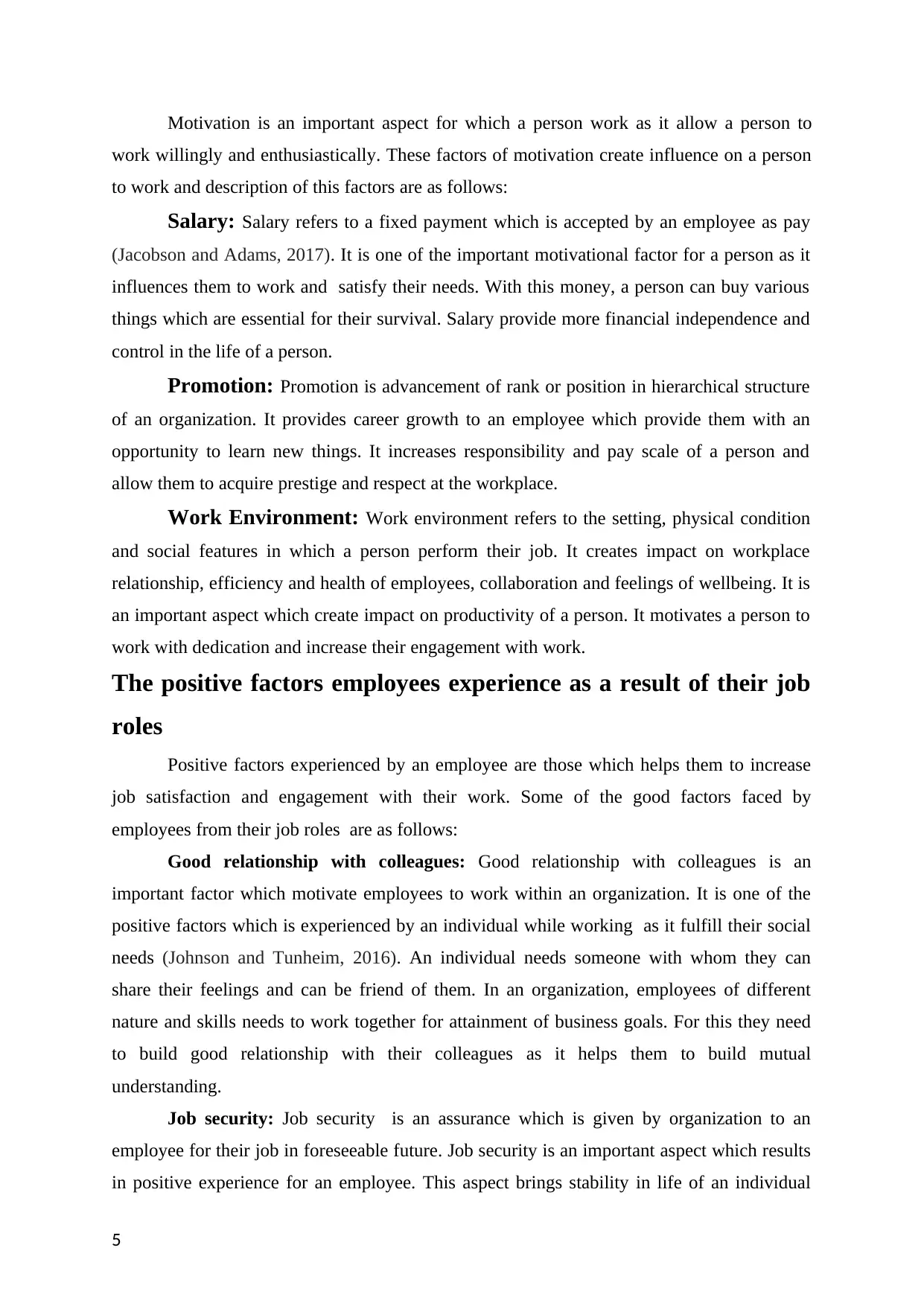
Motivation is an important aspect for which a person work as it allow a person to
work willingly and enthusiastically. These factors of motivation create influence on a person
to work and description of this factors are as follows:
Salary: Salary refers to a fixed payment which is accepted by an employee as pay
(Jacobson and Adams, 2017). It is one of the important motivational factor for a person as it
influences them to work and satisfy their needs. With this money, a person can buy various
things which are essential for their survival. Salary provide more financial independence and
control in the life of a person.
Promotion: Promotion is advancement of rank or position in hierarchical structure
of an organization. It provides career growth to an employee which provide them with an
opportunity to learn new things. It increases responsibility and pay scale of a person and
allow them to acquire prestige and respect at the workplace.
Work Environment: Work environment refers to the setting, physical condition
and social features in which a person perform their job. It creates impact on workplace
relationship, efficiency and health of employees, collaboration and feelings of wellbeing. It is
an important aspect which create impact on productivity of a person. It motivates a person to
work with dedication and increase their engagement with work.
The positive factors employees experience as a result of their job
roles
Positive factors experienced by an employee are those which helps them to increase
job satisfaction and engagement with their work. Some of the good factors faced by
employees from their job roles are as follows:
Good relationship with colleagues: Good relationship with colleagues is an
important factor which motivate employees to work within an organization. It is one of the
positive factors which is experienced by an individual while working as it fulfill their social
needs (Johnson and Tunheim, 2016). An individual needs someone with whom they can
share their feelings and can be friend of them. In an organization, employees of different
nature and skills needs to work together for attainment of business goals. For this they need
to build good relationship with their colleagues as it helps them to build mutual
understanding.
Job security: Job security is an assurance which is given by organization to an
employee for their job in foreseeable future. Job security is an important aspect which results
in positive experience for an employee. This aspect brings stability in life of an individual
5
work willingly and enthusiastically. These factors of motivation create influence on a person
to work and description of this factors are as follows:
Salary: Salary refers to a fixed payment which is accepted by an employee as pay
(Jacobson and Adams, 2017). It is one of the important motivational factor for a person as it
influences them to work and satisfy their needs. With this money, a person can buy various
things which are essential for their survival. Salary provide more financial independence and
control in the life of a person.
Promotion: Promotion is advancement of rank or position in hierarchical structure
of an organization. It provides career growth to an employee which provide them with an
opportunity to learn new things. It increases responsibility and pay scale of a person and
allow them to acquire prestige and respect at the workplace.
Work Environment: Work environment refers to the setting, physical condition
and social features in which a person perform their job. It creates impact on workplace
relationship, efficiency and health of employees, collaboration and feelings of wellbeing. It is
an important aspect which create impact on productivity of a person. It motivates a person to
work with dedication and increase their engagement with work.
The positive factors employees experience as a result of their job
roles
Positive factors experienced by an employee are those which helps them to increase
job satisfaction and engagement with their work. Some of the good factors faced by
employees from their job roles are as follows:
Good relationship with colleagues: Good relationship with colleagues is an
important factor which motivate employees to work within an organization. It is one of the
positive factors which is experienced by an individual while working as it fulfill their social
needs (Johnson and Tunheim, 2016). An individual needs someone with whom they can
share their feelings and can be friend of them. In an organization, employees of different
nature and skills needs to work together for attainment of business goals. For this they need
to build good relationship with their colleagues as it helps them to build mutual
understanding.
Job security: Job security is an assurance which is given by organization to an
employee for their job in foreseeable future. Job security is an important aspect which results
in positive experience for an employee. This aspect brings stability in life of an individual
5
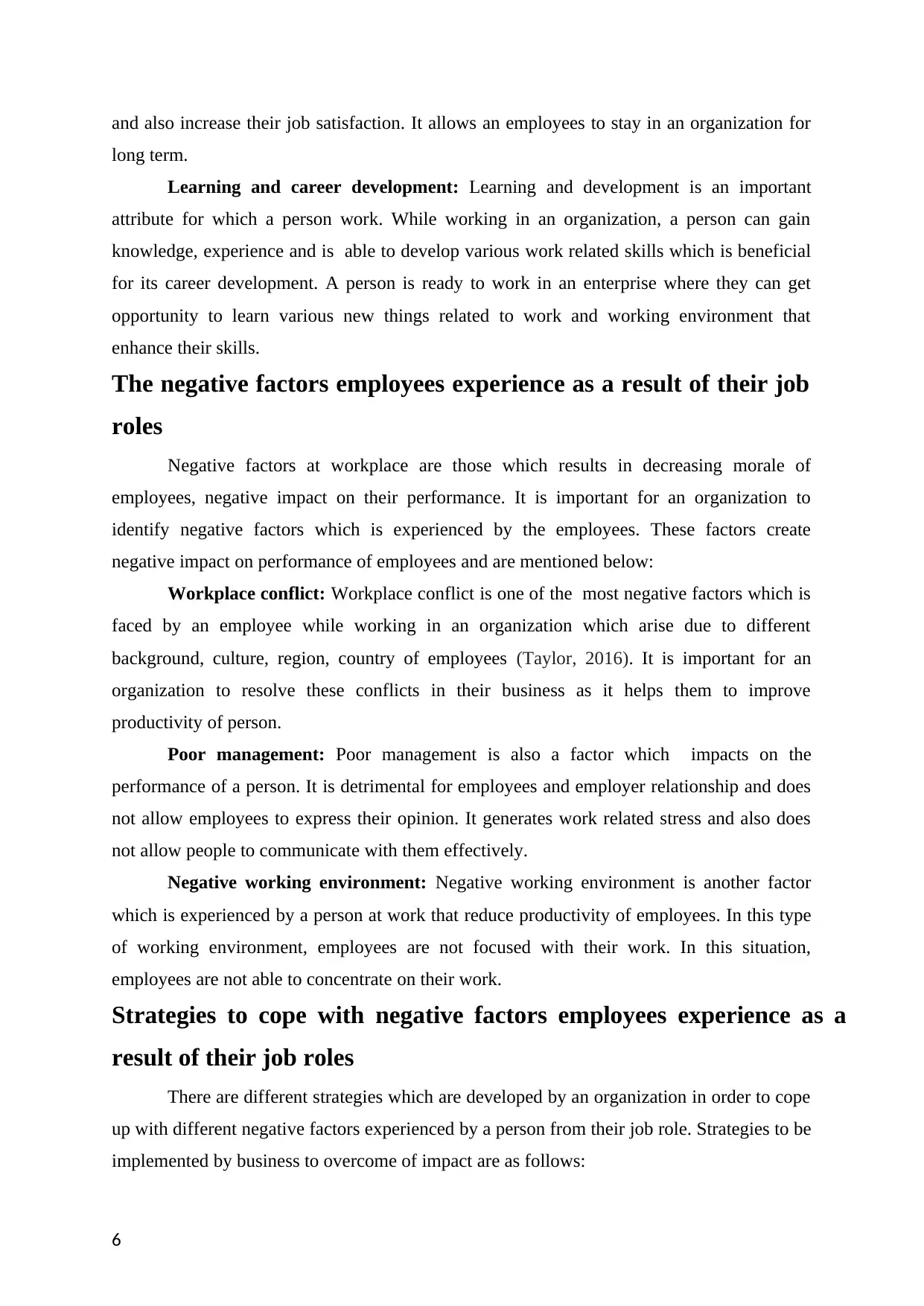
and also increase their job satisfaction. It allows an employees to stay in an organization for
long term.
Learning and career development: Learning and development is an important
attribute for which a person work. While working in an organization, a person can gain
knowledge, experience and is able to develop various work related skills which is beneficial
for its career development. A person is ready to work in an enterprise where they can get
opportunity to learn various new things related to work and working environment that
enhance their skills.
The negative factors employees experience as a result of their job
roles
Negative factors at workplace are those which results in decreasing morale of
employees, negative impact on their performance. It is important for an organization to
identify negative factors which is experienced by the employees. These factors create
negative impact on performance of employees and are mentioned below:
Workplace conflict: Workplace conflict is one of the most negative factors which is
faced by an employee while working in an organization which arise due to different
background, culture, region, country of employees (Taylor, 2016). It is important for an
organization to resolve these conflicts in their business as it helps them to improve
productivity of person.
Poor management: Poor management is also a factor which impacts on the
performance of a person. It is detrimental for employees and employer relationship and does
not allow employees to express their opinion. It generates work related stress and also does
not allow people to communicate with them effectively.
Negative working environment: Negative working environment is another factor
which is experienced by a person at work that reduce productivity of employees. In this type
of working environment, employees are not focused with their work. In this situation,
employees are not able to concentrate on their work.
Strategies to cope with negative factors employees experience as a
result of their job roles
There are different strategies which are developed by an organization in order to cope
up with different negative factors experienced by a person from their job role. Strategies to be
implemented by business to overcome of impact are as follows:
6
long term.
Learning and career development: Learning and development is an important
attribute for which a person work. While working in an organization, a person can gain
knowledge, experience and is able to develop various work related skills which is beneficial
for its career development. A person is ready to work in an enterprise where they can get
opportunity to learn various new things related to work and working environment that
enhance their skills.
The negative factors employees experience as a result of their job
roles
Negative factors at workplace are those which results in decreasing morale of
employees, negative impact on their performance. It is important for an organization to
identify negative factors which is experienced by the employees. These factors create
negative impact on performance of employees and are mentioned below:
Workplace conflict: Workplace conflict is one of the most negative factors which is
faced by an employee while working in an organization which arise due to different
background, culture, region, country of employees (Taylor, 2016). It is important for an
organization to resolve these conflicts in their business as it helps them to improve
productivity of person.
Poor management: Poor management is also a factor which impacts on the
performance of a person. It is detrimental for employees and employer relationship and does
not allow employees to express their opinion. It generates work related stress and also does
not allow people to communicate with them effectively.
Negative working environment: Negative working environment is another factor
which is experienced by a person at work that reduce productivity of employees. In this type
of working environment, employees are not focused with their work. In this situation,
employees are not able to concentrate on their work.
Strategies to cope with negative factors employees experience as a
result of their job roles
There are different strategies which are developed by an organization in order to cope
up with different negative factors experienced by a person from their job role. Strategies to be
implemented by business to overcome of impact are as follows:
6
⊘ This is a preview!⊘
Do you want full access?
Subscribe today to unlock all pages.

Trusted by 1+ million students worldwide
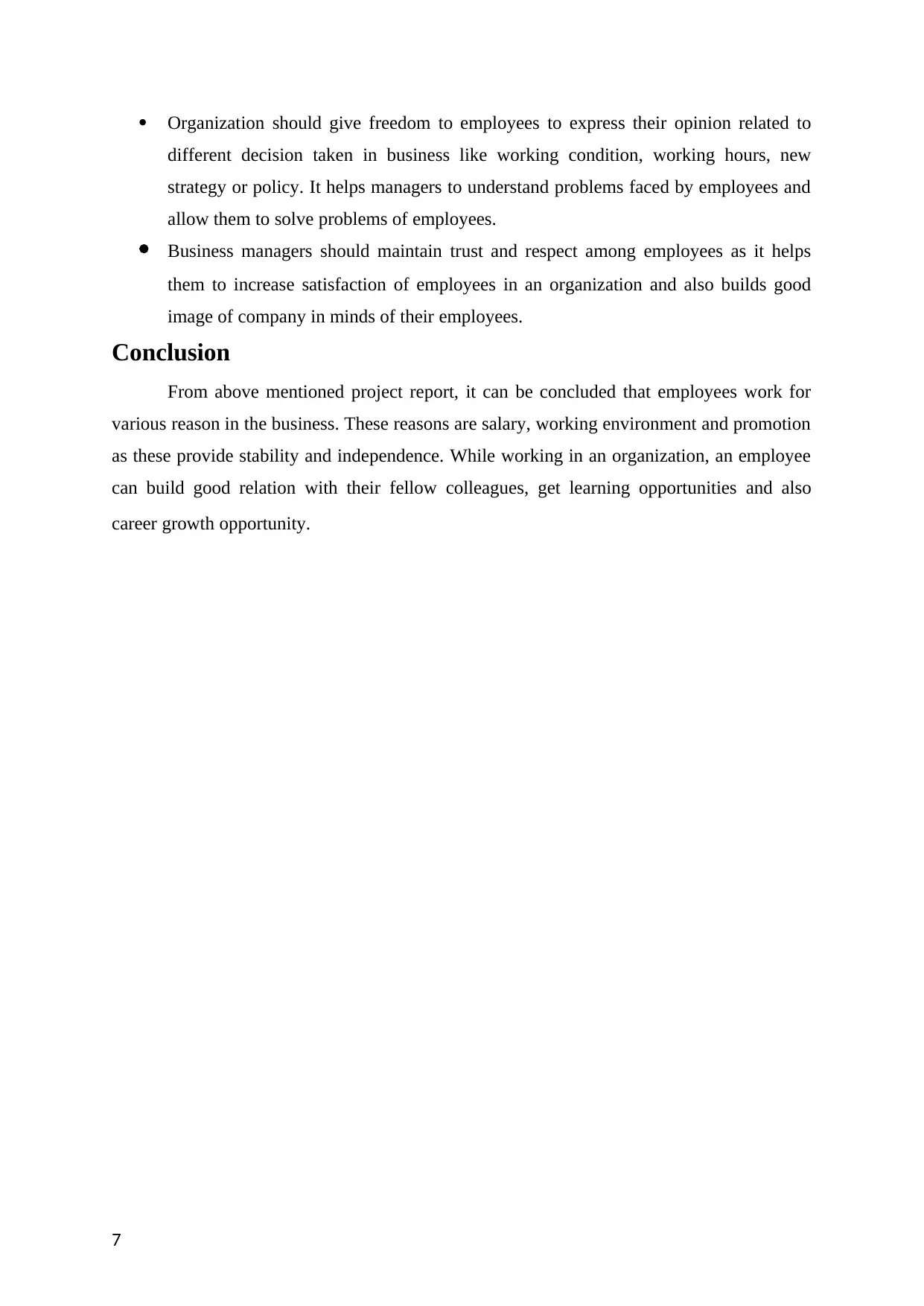
Organization should give freedom to employees to express their opinion related to
different decision taken in business like working condition, working hours, new
strategy or policy. It helps managers to understand problems faced by employees and
allow them to solve problems of employees.
Business managers should maintain trust and respect among employees as it helps
them to increase satisfaction of employees in an organization and also builds good
image of company in minds of their employees.
Conclusion
From above mentioned project report, it can be concluded that employees work for
various reason in the business. These reasons are salary, working environment and promotion
as these provide stability and independence. While working in an organization, an employee
can build good relation with their fellow colleagues, get learning opportunities and also
career growth opportunity.
7
different decision taken in business like working condition, working hours, new
strategy or policy. It helps managers to understand problems faced by employees and
allow them to solve problems of employees.
Business managers should maintain trust and respect among employees as it helps
them to increase satisfaction of employees in an organization and also builds good
image of company in minds of their employees.
Conclusion
From above mentioned project report, it can be concluded that employees work for
various reason in the business. These reasons are salary, working environment and promotion
as these provide stability and independence. While working in an organization, an employee
can build good relation with their fellow colleagues, get learning opportunities and also
career growth opportunity.
7
Paraphrase This Document
Need a fresh take? Get an instant paraphrase of this document with our AI Paraphraser
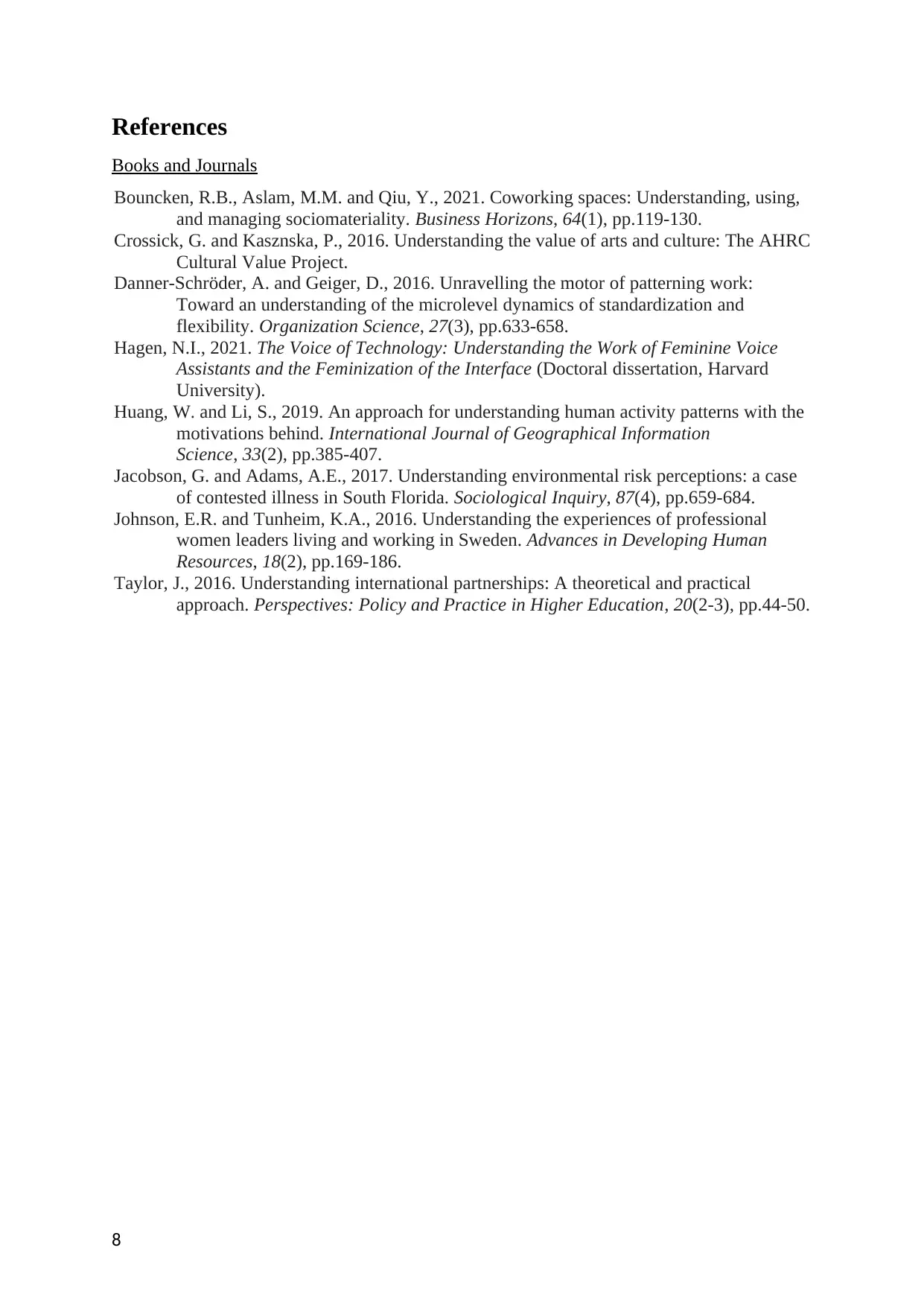
References
Books and Journals
Bouncken, R.B., Aslam, M.M. and Qiu, Y., 2021. Coworking spaces: Understanding, using,
and managing sociomateriality. Business Horizons, 64(1), pp.119-130.
Crossick, G. and Kasznska, P., 2016. Understanding the value of arts and culture: The AHRC
Cultural Value Project.
Danner-Schröder, A. and Geiger, D., 2016. Unravelling the motor of patterning work:
Toward an understanding of the microlevel dynamics of standardization and
flexibility. Organization Science, 27(3), pp.633-658.
Hagen, N.I., 2021. The Voice of Technology: Understanding the Work of Feminine Voice
Assistants and the Feminization of the Interface (Doctoral dissertation, Harvard
University).
Huang, W. and Li, S., 2019. An approach for understanding human activity patterns with the
motivations behind. International Journal of Geographical Information
Science, 33(2), pp.385-407.
Jacobson, G. and Adams, A.E., 2017. Understanding environmental risk perceptions: a case
of contested illness in South Florida. Sociological Inquiry, 87(4), pp.659-684.
Johnson, E.R. and Tunheim, K.A., 2016. Understanding the experiences of professional
women leaders living and working in Sweden. Advances in Developing Human
Resources, 18(2), pp.169-186.
Taylor, J., 2016. Understanding international partnerships: A theoretical and practical
approach. Perspectives: Policy and Practice in Higher Education, 20(2-3), pp.44-50.
8
Books and Journals
Bouncken, R.B., Aslam, M.M. and Qiu, Y., 2021. Coworking spaces: Understanding, using,
and managing sociomateriality. Business Horizons, 64(1), pp.119-130.
Crossick, G. and Kasznska, P., 2016. Understanding the value of arts and culture: The AHRC
Cultural Value Project.
Danner-Schröder, A. and Geiger, D., 2016. Unravelling the motor of patterning work:
Toward an understanding of the microlevel dynamics of standardization and
flexibility. Organization Science, 27(3), pp.633-658.
Hagen, N.I., 2021. The Voice of Technology: Understanding the Work of Feminine Voice
Assistants and the Feminization of the Interface (Doctoral dissertation, Harvard
University).
Huang, W. and Li, S., 2019. An approach for understanding human activity patterns with the
motivations behind. International Journal of Geographical Information
Science, 33(2), pp.385-407.
Jacobson, G. and Adams, A.E., 2017. Understanding environmental risk perceptions: a case
of contested illness in South Florida. Sociological Inquiry, 87(4), pp.659-684.
Johnson, E.R. and Tunheim, K.A., 2016. Understanding the experiences of professional
women leaders living and working in Sweden. Advances in Developing Human
Resources, 18(2), pp.169-186.
Taylor, J., 2016. Understanding international partnerships: A theoretical and practical
approach. Perspectives: Policy and Practice in Higher Education, 20(2-3), pp.44-50.
8
1 out of 8
Related Documents
Your All-in-One AI-Powered Toolkit for Academic Success.
+13062052269
info@desklib.com
Available 24*7 on WhatsApp / Email
![[object Object]](/_next/static/media/star-bottom.7253800d.svg)
Unlock your academic potential
Copyright © 2020–2025 A2Z Services. All Rights Reserved. Developed and managed by ZUCOL.

